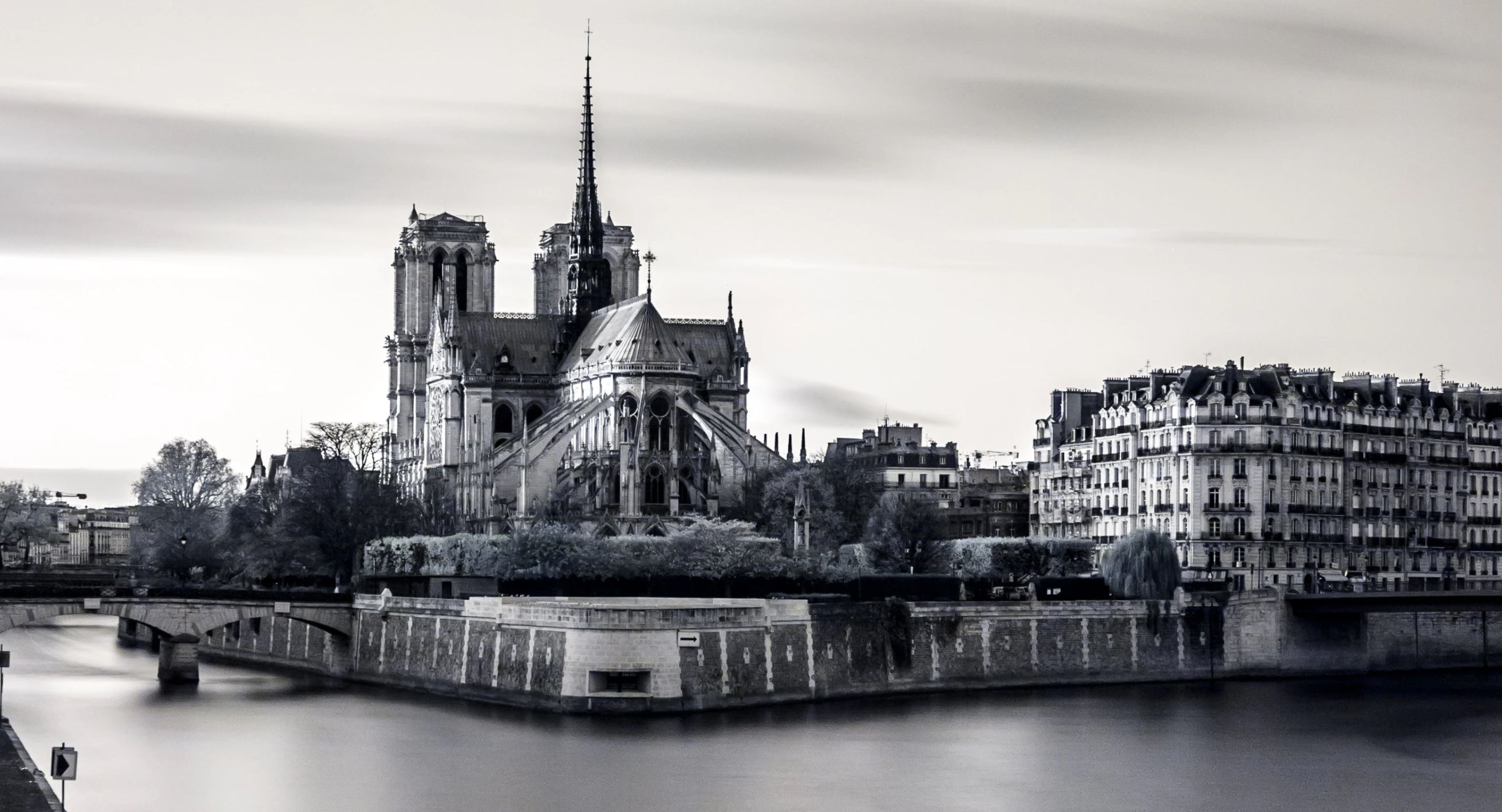Photo by Mathieu-Perrier/Unsplash
**
Notre-Dame de Paris and a reflection on Progress
by Fabia Chenivesse-Wong
Columnist
The bishop of Paris commissioned the construction of Notre-Dame de Paris in the 12th century. It was to replace the cathedral of Saint-Etienne, itself of enormous proportions and a successor to earlier churches, and before that, a pagan temple. The first stone of the new cathedral was laid in 1163, and it took nearly a century to complete construction. Since then, Notre-Dame has borne witness to great change: a succession of kings, bloody revolutions, the establishment of a short-lived commune, emperors, a Nazi occupation, and five Republics. It has not, however, stood untouched by time: the statues of the French kings that once adorned a gallery on high were destroyed during the Revolution, and in 1843, the cathedral underwent an ambitious restoration under the direction of Viollet-Le-Duc, the architect responsible for the renewal of the medieval fortifications of Carcassonne, among other monumental projects around France.
On 15 April 2019, Notre-Dame de Paris was engulfed in flames. The nation was moved. President Macron postponed a long-scheduled speech announcing the measures to be taken following his “Great Debate”, itself a reaction to the weekly gilets jaunes demonstrations that have paralyzed parts of France each Saturday. On this rare occasion, the President accurately captured the mood of his countrymen: it was a moment for pause and reflection.
There are reminders of France’s Catholic heritage in every corner of the country. No matter how small the village, one can count on the presence of an eglise, a mairie, a boulangerie, and a tabac. Faith, the state, bread, and cigarettes: ingredients of the French Republican diet. Since the Revolution, France has remained for the most part committed to laïcité, a French form of secularism that protects freedom of conscience and a separation between church and state. Laïcité was a clear-eyed reaction to the dangers of doctrine and institutions impermeable to scrutiny or criticism having direct influence on the state. By the time the revolution came to France, the ruling partnership between the ancien régime and the Catholic Church had long fallen into decadence with the cost borne by the people of France. Laïcité was not easily won; the implementation of secularism in France took longer than the construction of Notre-Dame de Paris.
Catholicism persists as the nation’s most practiced religion, but over time, the number of faithful has declined, as has been the case across the countries that count themselves amongst the protectors of Western civilization. Religion and spirituality have been eclipsed by science and materialism. Naturally, one then questions why the near destruction of a centuries-old monument to faith has evoked a response of such magnitude.
Notwithstanding the time originally taken to build the cathedral, President Macron has pledged to rebuild it in five years, “even better” than before. In defending his ambition, Macron invoked Viollet-Le-Duc, whose controversial approach to restoration was not to reproduce the original work, but to execute the true, completed vision behind it, using all available modern technologies. Viollet-Le-Duc, however, held a deep respect for medieval gothic architecture; less clear is whether the current President shares this respect for the past, or is simply a skilled rhetorician. Whatever Macron’s beliefs may be, the crux of his message is evident: what has been accomplished in the past, we can do better, and faster.
The notion of progress is central to the capitalist construct. It is built into the bedrock purpose of enterprise – to develop new goods and services to address existing needs, and when those are satisfied, to generate new needs. Better cars, better homes, better quality of life, ad infinitum. But what started as the driving force of an economic system meant to improve upon the patent unfairness of the ancien regime has evolved into a social and cultural raison d’être. To exploit the as-yet-unexploited niche is a quest without end, beckoning progress for the sake of progress, and profit for the sake of profit.
So, too, is progress elemental to science. Even in its purest form, structured around the publication of peer-reviewed studies, science incentivizes the generation of novelty, even when the perceived advance is artificial, useless or worse. To not publish is to not exist, or to exist in a dark basement without funding. This shared commitment to advance for the sake of advancement perhaps partially explains the strange and fruitful symbiosis between capitalism and what increasingly appears to be its state religion, science.
One of the most seductive promises of science is transparency – a corollary to the promise of meritocracy indispensable to capitalism. With the decline of religion arrived an end to penitence and acceptance, edicts issued from an obscure God and his shadowy representatives, living for the sake of an unknowable afterlife. Instead, with the Enlightenment came methodology, peer-review, openness and objectivity: the fundamentals of Good Science, in lockstep with the unassailable logic of capitalism, and democracy.
In early May, the French daily newspaper Le Monde revived a 2015 New York Times story, covering Coca Cola’s nefarious efforts to mold the science of obesity, shifting the blame for weight gain from excess caloric consumption to a lack of exercise (https://www.lemonde.fr/planete/article/2019/05/08/enquete-sur-la-science-sous-influence-des-millions-de-coca-cola_5459509_3244.html). The article examined the information that Coca Cola had been pushed to release after the story first broke, revealing that the corporation spent eight million euros over a decade in France, paying health professionals and medical industry leaders between 700 and 4000 euros to advance its commercial interests or to otherwise erode confidence in the link between sugary drinks and obesity. Some scientists who received research funding from Coca Cola and whose conclusions did not conform to the desired result simply did not publish.
Perhaps the most disconcerting revelation of the Le Monde investigation was the ease with which corruption took hold. One eminent scientist interviewed considered that accepting the money did not present a conflict of interest and was not out of the ordinary; it was simply the way that it all works.
In spite of its ardent pledge for transparency in 2016, once some time had passed and the spotlight had dimmed, Coca Cola’s enthusiasm for disclosure diminished. Even if it had lived up to its promises, too much information can be as opaque as no data at all. To hold the company to account would require not only sustained pressure from NGOs and investigative journalists, but enforceable legal instruments, and concerted political, prosecutorial and consumer will. The question of corporate liability, in a day and age when the corporate entity has infiltrated every aspect of public life, is still frustratingly unanswered.
Coca Cola is by no means unique, nor are the problems it presents by any means novel. Transparency is not enough to maintain the health of any institution, just as the invisible hand cannot on its own ensure a fair and free market, and laws based upon a presumption of good faith are insufficient to stay the hand of a would-be tyrant. One would be hard-pressed to find an example in history where the self-regulation of powerful individuals or organizations has worked. Unchecked, the institutions of Western civilization have become corrosive: to human dignity, to art, and, perhaps on a larger scale than ever before, to the natural world.
To revere progress as an end in itself is to abandon our past and to relinquish the lessons of history. It also requires turning a blind eye to the patent superiority of so many relics from the past, Notre-Dame de Paris being just one example. Like any flight from truth, it makes us less free. It has us running a race to the bottom, devaluing those things that cannot be commoditized and concealing a lack of purpose, imagination and vision with unabashed ambition. It is the equivalent of building, in the place of cathedrals like Notre-Dame de Paris, a garish temple to ourselves.
Today, we privilege profit over durability and beauty. It is difficult imagining a project like Notre-Dame de Paris, requiring generations to construct; the current iteration of Western civilization has rendered that form of venture all but obsolete. The Sagrada Familia in Barcelona, in construction for the last 135 years, is perhaps the exception that proves the rule.
Notre-Dame de Paris has touched countless souls, French and otherwise. It is a symbol of grace and timeless beauty, and a memorial to what human beings are capable of, what profound ambition can yield, when not motivated solely by personal gain. It is also a reminder that no matter how divine the purpose, every institution is susceptible to decadence and corruption. The reaction to the fire this April revealed something, something perhaps unutterable in a world where public discourse has been completely overtaken by the rhetoric of economics, or the seemingly objective precision of science. Maybe, in spite of whatever temporary folly might befall us, there is something in the human spirit that responds to beauty, and to truth.
About the author:
 Fabia Chenivesse-Wong. Fabia studied and practiced law at a regional law firm in her hometown of Toronto, Canada, before moving to The Hague, the Netherlands, in 2011. For six years she worked for UN tribunals, prosecuting international crime. Currently based in the south of France, she writes about gender, race, culture and the law.
Fabia Chenivesse-Wong. Fabia studied and practiced law at a regional law firm in her hometown of Toronto, Canada, before moving to The Hague, the Netherlands, in 2011. For six years she worked for UN tribunals, prosecuting international crime. Currently based in the south of France, she writes about gender, race, culture and the law.

Recent Comments